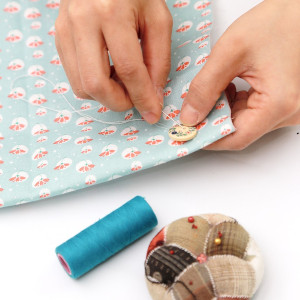 Have you been thinking about getting serious about sewing? If so, you are going to need to learn the best hand sewing techniques. Even though your sewing machine will do most of the work on your behalf, if you really want to be a professional seamstress or tailor, you must learn some old-fashion hand stitching techniques.
Have you been thinking about getting serious about sewing? If so, you are going to need to learn the best hand sewing techniques. Even though your sewing machine will do most of the work on your behalf, if you really want to be a professional seamstress or tailor, you must learn some old-fashion hand stitching techniques.
Why? For a couple of reasons. Firstly, there are some things that your machine cannot do, and that you will need to complete yourself with your bare hands like it were 1307 and we hadn’t invented toilets yet.
Secondly, because it’s fun. Some people may argue with me, but I personally think there is no better feeling than soft fabric between your hands, the cold steel of the needle between your fingers, and the satisfying sound and sensation of personally pulling the thread through the fabric.
Here are some of the best handselling techniques.
Running Stitch
The running stitch is perhaps the most common stitch and the most well-known. This is the simple process of putting the needle through your fabric and then pulling the needle out of your fabric. Easy, right? You can even stick your needle in and out of the fabric at custom lengths multiple times, then draw the stitch through afterward to complete a bunch of stitches at once.
The great thing about the running stitch is its simplicity. The needle goes in one side and out the other. Also, you can make very tight stitches in very specific areas using the running stitch, which your sewing machine may be unable to do.
Back Stitch
The backstitch is another classic. This is a combination of using a running stitch with a reverse backstitch for extra strength. These stitches are often used by professionals when they are mending seams or stitching a seam that needs to hold strong to a lot of straining and pulling.
The backstitch works like this. Make a single running stitch, starting from the underside of the fabric. You want to keep the stitch taut by pulling it from underneath the fabric, then skip forward a space and bring the needle back down through the last hole of your stitch, creating a strong backward stitch. You basically retrace your steps to add more thread where it counts.
Whip Stitch
 The whip stitch is incredibly easy, especially considering some of the other hand techniques out there. In general, the whip stitch is used for hemming and is made of short but strong diagonal stitches.
The whip stitch is incredibly easy, especially considering some of the other hand techniques out there. In general, the whip stitch is used for hemming and is made of short but strong diagonal stitches.
It almost looks like weaving a book spine with thread. You want to pull your needle through the top of the two fabrics, ensuring the knot is kept firmly between them, then penetrate the bottom fabric and exit in the exact same location that you started on the upper fabric. Congratulations, you have just locked your initial stitches.
Next, the needle goes through the bottom fabric, thus making a diagonal stitch at the border of your two fabrics. This is why it looks like a book spine. However, you must exit through the top of the fabric in order to secure them together. The process goes on until you have reached the end. And be sure to lock your stitches.
Securing Stitch
The securing stitch is critical for ending your project. You have to stop somewhere, right? And the securing stitch is excellent to keep your hard-worked stitches from getting loose or falling out.
It is very easy. Just make a small backstitch at the end, make a loop thread, then take the needle through the loop, then do it two more times. You will finish off with a very sturdy knot. There will be absolutely no loosening of your threads.
Basting Stitch
The basting stitch is a temporary stitch that is used to hold together two pieces of fabric. This is generally done with a different color than the fabric you used to do your normal stitching. That way you can easily recognize your basting stitch and then pull it out later.
To create a basting stitch, simply weave the needle in and out of the fabric several times, making large, straight stitches, before you pull it through. This will easily hold the fabrics together. Just remember not to lock the stitches when you do this.
Catch Stitch
Catch stitches are easily identifiable by their crisscrossing pattern. This technique is fantastic to use for fabrics that are front-facing or for circular garments, such as tablecloths. The catch stitch is going to allow for more give than with a normal straight stitch, which is why it is so great on circular things.
First, you need to start on the left. You will start off at the opposite side from where you normally start, then pull your needle through the fabric and make a diagonal stitch. Now you can make another diagonal stitch going back to the other side of the fabric. All you must do is repeat the process, going back and forth with diagonal lines, until both fabrics are firmly attached.
Blind Hem Stitch
The blind hem stitch is a technique used to create invisible hems. It is very similar to a ladder stitch. For silky or light fabrics, this is a must-know stitch to create the hem.
All you need to do is slip the needle beneath the folded part of the fabric, which will hide the knot. Once you are underneath, pull the needle out and then through. Then grab some of the fabric where the hem sits, grab the part of the fabric that is folded from your starting side, and repeat the exact same pattern until the opening is finished.
Final Thoughts: Hand Sewing Techniques
These are only some of the very useful hand sewing techniques that you will learn on your journey to becoming a professional seamstress or tailor. There are many more techniques out there, most of which you can easily find online. If you have friends who have been sewing for a long time, they can probably teach you even more interesting hand techniques that you will never read about on the internet.



